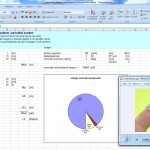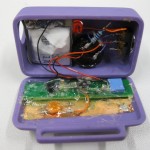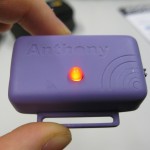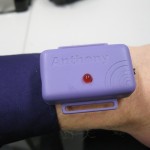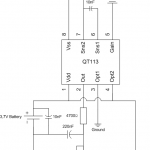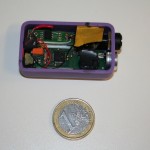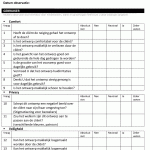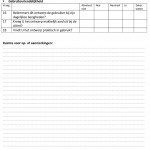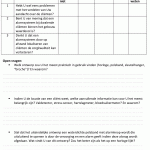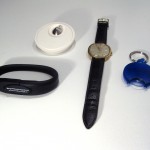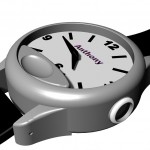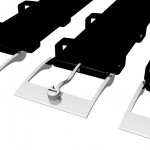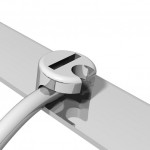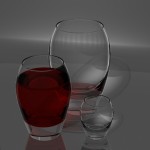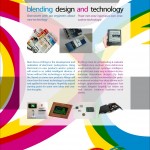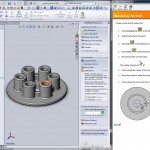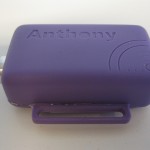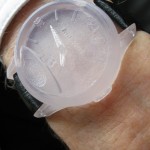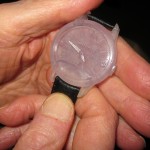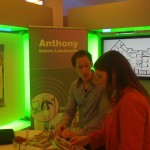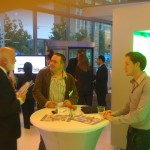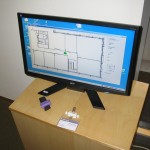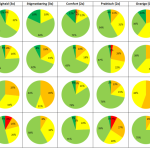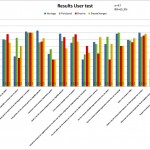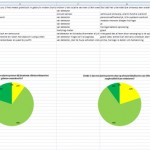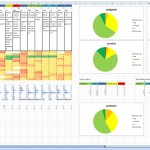FBP “Retrieve Anthony’s Transponder”
Final Bachelor Project “Retrieve Anthony’s Transponder”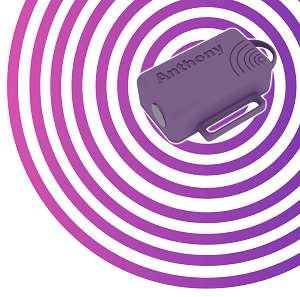
Coach: dr.ir. F.L.M. (Frank) Delbressine
Theme: Medical Care
Coach Feedback (ONLY VIEWABLE AFTER LOGIN IDCOMPASS!)
Feedback Frank Hendriks (manager healthcare at De Archipel)
Feedback Herman Aartsen (system engineer at Wingz)
Feedback Ron Niesten (manager Wingz)
Project description:
People wearing Anthony’s transponder can be located and traced within a building very specific. During the second semester of 2009, Industrial Design student Maarten Geraets supported the team of Anthony to implement their system in intramural health departments.
Concept description:
The final concept is a specialized watch that is less stigmatizing and includes Anthony’s technology. The watch has an alarm-button, wearing-detector and a specialized buckle to improve the reliability of the system. The watch improves the care quality, supports the nursery’s staff by knowing where their clients are within a building and alerting them is case a client is wandering. This watch supports elderly in returning their freedom in nursery houses.
Competencies developed:
1,2,3,5,6,A,B,C,D
Reflection
Project explanation
As B3.1 student, I have to gather practical experience in the field of Industrial Design during an internship-period. As B3.2 student, I have to complete my Final Bachelor Project on academic grade. Therefore, this project is very suited to combine these two semesters. During the summer holiday, I performed part-time work at the Company Wingz. Subsequently Wingz asked me whether I would perform my internship at their company. I contacted nursery house De Archipel if they would participate within my project, which they accepted. This proposal was accepted by the board of examiners.
My vision as designer and Wingz
This project fits well towards my vision as designer because I enjoy designing by helping people using intelligent products and services. I want to create innovative designs what make our life easier and more enjoyable. Designing a product that enables health-departments to improve their care quality is very satisfying for me as designer. In addition, technology, innovation, intelligent products and gadgets fascinate me. I am well experienced with technology and aware of the newest technologies. This enables me to realize creative designs using contemporary technologies. I can create and test interactive prototypes on users to gather vital feedback. Therefore, Wingz is a very suited company to do my final bachelor project. Bigger companies do not allow me to get involved in the whole design-cycle and don’t provide me the freedom to do what I want and what to learn. Wingz is specialized in embedded systems, which fits very well to my vision and ability as designer due to my affinity with technology. In addition, this company represents the work-environment that I will be facing within a few years; designing consumer electronics.
1. Ideas & concepts
By interviewing and performing research concerning stakeholders within the project, I was able to create a list of sufficient demands and wishes, as you can see on page 25 of the report. This provided me solid founding to focus on during concept development and evaluation. However, in the upcoming projects I should be more critical concerning describing the terms. I.e. what is cheap? and what is lightweight? By adding numbers to these criteria, it is easier to evaluate design decisions on an abstract level. I should me more critical on this next time. During the idea generation phase I used several techniques learned from previous projects and the assignment creative techniques: thinking outside the box (like random trigger and MATEC) as well abstract (Acting Out and Provocative analogy), in order to come up multiple ideas. I learned this combination enables me to come up with a wide variety of ideas. However, I think it would have been better include more creative techniques concerning the use of suited materials, morphologic analyses (cardboard/foam/clay, as in the assignments Cardboard Modelleling and Model Making) and the use of a suited closing mechanism of the watch design. This would have broadened my vision concerning the different design decisions. Next time I have to go deeper into these phases. During the idea selection phase, I performed a pre-selection to filter the most relevant ideas for user testing. Therefore, I made a matrix that ranks the possible ideas based on the demands list I stated before. However, I learned that this is a very critical point, because ranking is relative and can be influenced by a shortage of knowledge. Therefore, I discussed my ranking with experts: a system engineer and employees of the nursing house concerning technological possibilities and practical issues. This gave me trust in ranking the ideas. I realized that this method in combination with itemized response technique is a very solid way to select the most suited ideas.
2. Integrating Technology
During the project, I made a functional prototype that senses the presence of the human body. I became more competent in designing and manufacturing interactive prototypes. In addition, I became more aware of the internal components of electronical designs. I searched for suited components on web shops, measured the sizes, soldered them together and performed calculations concerning the battery lifetime (not included in the project report unfortunately). I also saw at neighbor companies of Wingz, VEDS and Q-Matrix, how these components are produced, combined, tested and programmed professionally. From these activities, I got more practical experience that I have to take in mind while designing, like internal volume, technical possibilities/limitations and production techniques.
Pictures of Technology Integration, designed wearing detector and components transponder
3. User focus
This project had a very difficult user group to design for: (heavy) demented elderly. I performed research to become more empathized in this target group. This included reading literature and gathering practical experience by visiting De Archipel twice a week for interviews with employees and imagine myself into the situation. From these activities, I was able to get a clear picture of the desires of the user. Afterwards I checked these assumptions by interviewing staff and processing them into proposals using the co-reflection method, learned from the Project Supporting Sportsmanschip). I learned that this is a very effective way to check design decisions concerning the user. Unless the good preparation, the performed user test was difficult to gather information from the elderly directly due to their ‘unconsciousness’, the employees assisted me in gathering useful user information. I learned it is very useful to use a questionnaire what includes theorems that can be ranked on a relative scale and has space for comments. I learned that I have to be objective when creating questionnaires. I should not directing towards a complete final solution (i.e. How about a bracelet including this and that?). The danger what might occur is that people continue focusing on that idea on a straight line, without considering the other possible concepts (“yes, THAT is what we want”). Additionally I learned the use of subject-clustering, mirrored questions, control-questions, sub-scales and weights, secondary questionnaires and proposing final concepts are very useful to get results that are more reliable. However, I should be more critical next time selecting designs for the user test. This time I used designs that might not present the properties (size, weight, robustness) of final designs, which might affect the reliability of the user test. Furthermore, I should check in advance the influence of prior experience of a spectacular design, like occurred this time. In addition I concluded it’s a pity it was not possible to perform an second user test at the same scale as the first one (8 users tested, questionnaire: n=47, response rate=65,3%), to get more solid foundation for concept development. Next time I should search for better alternatives when the support is lacking (like it happen this time at time of starting the second user test). Analyzing of the data is discussed in analyzing complexity. The used questionnaires are shown below:
Pictures of the used questionnaires
5. Business design and processes
At the company Wingz I was able to gather knowledge concerning the practical issues of running a business company. I learned a wide variety of business partners is important to exchange assignments and to perform business. I saw that managers of companies often concern more about the profit than a proper developed product. Subsidy is often a motivation for companies to manufacture products. In my project and visiting the domestic fair, I saw that designing for healthcare facilities concerns a “technology push” situation: many companies manufacturing high-tech products what they think is useful. However using it in practice is another story. I learned that as designer I have to focus on the end-user and not the managers, who is lacking of practical experience sometimes. In this way, I can focus on a good founded and suitable design. I realized that healthcare facilities would rather see a reliable, working and ugly product, than a beautiful but not functioning one. In addition, I attended to several business meetings with my boss. I realized that during business meetings it is very important to include facts, numbers, and financial issues to convince business managers to participate. It is also important to stick to the simplicity of the solution, which single problem it solves and what is in it for the business partner. By designing something which has multiple options (indoor-location and fall-detector and heart-rate etc..) confuses managers which will pull out very quickly than. What’s more, I learned to be very careful to share thoughts with other people. Business meetings are interesting, but also for the competitors. Juridical issues are very complex and restricting while designing. As designer, I should never share the complete picture of my concept, even if it seems that interesting to gather concept-improvements. I also get more experience empathizing myself in the business point of view, by analyzing an internal design project (ChestBox)and interviewing Wingz employees. Before a product can be manufactured a lot of research, competitor analyzing, testing, production, manufacturing has to be performed. This is a huge investment a company has to do. Therefore as manager, it is very important to be sure it will eventually profitable. In addition, the amount of products and the most suited manufacturing method should be considered in advance; sometimes it is cheaper to board assignments partly to another company. In my case, it was cheaper to buy ready to use watchcases, which I did not understand at first sight by overlooking the investment costs. As designer I should also looking forward by thinking of the after sale services; like installation-methods, software-upgrades and problem-solving activities of my designs.
6. Form & senses
One of my goals was to increase my CAD-skills. I had some minor experience with Rhinoceros before. By following tutorials and trying out myself, I became more skilled using the Flamingo render (plug-in for Rhinoceros), in order to create photorealistic renders for (re)presentation purposes. This includes the different variables of materials, lighting methods, transparency and ray tracing.
Renders I made using the gathered Flamingo-skills
During manufacturing the watch for my project, I have learned that Rhino is not suited for Rapid Prototyping methods, and I have to stick to the Solid Works application. I performed several Solid Works tutorials to become more experienced with this CAD application, but in the future I have to practice more to get more skilled with this application in order to create more advanced rapid prototype models. Furthermore I learned that, while using CAD-applications, I have to take in mind the material’s properties the design is made of, the minimum wall thickness, the density and forces on the design and the use of support material where needed. Next to the watch, I also designed the purple transponder device, which is used at five nursery houses for testing purposes. Moreover, I learned I have to trace sketches within Adobe Illustrator to make them more professional looking. Furthermore, I became more skilled in designing posters. Below you can see the poster I made for the Dutch Design Week.
Poster, SW practice and models created by RP-manufacturing
A. Multi-disciplinary teamwork
During this project, I contacted many experts (see report page 59) to gain valuable knowledge, but also different point of views and concerns. I learned that as designer I am in charge, others should not influence me too much and it is up to me making compromises. Still, I should have solid founding for decisions. In addition I presented the Anthony system a few times (such as international congress at High Tech Campus and during Dutch Design Week). The company Wingz gave me the trust to design some posters and presenting at the Anthony stand. This improved my professional attitude as well my presentation skills. I learned using prototypes and physical representations, I could improve the attraction towards the audience. Furthermore, it becomes easier for the audience to understand what I am showing. Also sticking to the simplicity, showing the audience what is in it for them and what it might contribute to the society (improving quality of health care and less costs for the insurance companies for instance) are very important issues to mention while presenting.
Presentations of Anthony system during International Congress and Dutch Design Week
B. Design & research process
Looking back at my project the division between research and designing was 50/50. In my opinion, research is very important to provide solid founding for concept development. I read literature, analyzed competitors, visited and interviewed staff of nursery houses to get sufficient information concerning the user. Looking back, I believe that a division of 40/60 would have been better. In that case, I have solid founding by research, and fine-tuning the design by interviewing and focus groups would have let to better-suited design. In addition, I could check my assumptions based on the preceding research. Then, I would be able to earlier in the design process that the use of an alarm-button would have been more suited for less demented elderly. In other words, trial and error is preferred above academical research in this case, but should defiantly be my starting point.
In addition I was focused too much on the watch design and making a physical prototype. I think this is caused by the increased time of the idea selection phase and second user test I wanted to perform. I focused too much finding confirmation for the watch design, rather than broadening the horizon with different watch designs (see chapter ideas & concepts). The next time I should look at a more abstract and objective level towards my design development.
C. Self-Directed and Continuous Learning
I learned that while designing I have to focus on and stick to a concrete hypothesis to give direction to my project. In addition, I learned to make sure that I have to make decisions and compromises based on external input. Nevertheless, I also learned that I should not be dependant of feedback of stakeholders completely: this is not always objective, independent or representative.
I also learned that I have to be more critical towards myself concerning designing. Because I am often that much focusing on a single activity, I lost the overall picture of the project sometimes. In the upcoming projects, I will force myself to evaluate my design process objectively and independent every two weeks.
In order to reflect upon myself regularly I decided use a digital diary that I update right away when I complete an educative task. This provides me a good way to evaluate my progress as designer. In addition, at time of making this showcase I interviewed myself in order to get relevant information concerning competency development. I learned that these two useful methods support me with reflecting and regulating upon myself.
D. Analyzing complexity
During the project, I analyzed the data gathered from the user test. The questionnaire I made is based on the Mayhew method, learned from the UFP assignment, to get objective results concerning the practical use and wearing comfort of the concepts. In addition, I contacted several experts and read a book (Health Measurement Scales by David L. Streiner and Geoffrey R. Norman) concerning data analyzing. In order to process the data scientifically, I learned that it is important to know what variable I am investigating, which scale-type I am using (nominal, ordinal, interval or ratio) and which statistical method fits the best. This provides transparency towards my research and interested. While analyzing the data of the user test I made the mistake to use the wrong method (interval vs. ordinal data) and concluded that everybody has different interpretation of the terms, like safety. In addition, I learned that statistical analyses should be performed very wisely, because they can affect the design direction dramatically. I also learned that is very useful to use sub-scales, classify items and adding weight to these items based on the design criteria to underline to most relevant information and to process this information into a final judgment. Besides I learned the graphs is dependable of which data I’m plotting. With this information in mind, I am capable of setting up methods for gathering and analyzing scientific data for design decisions.
Analysing data
